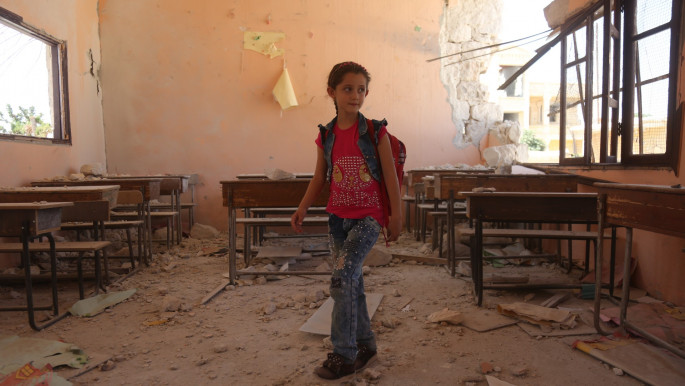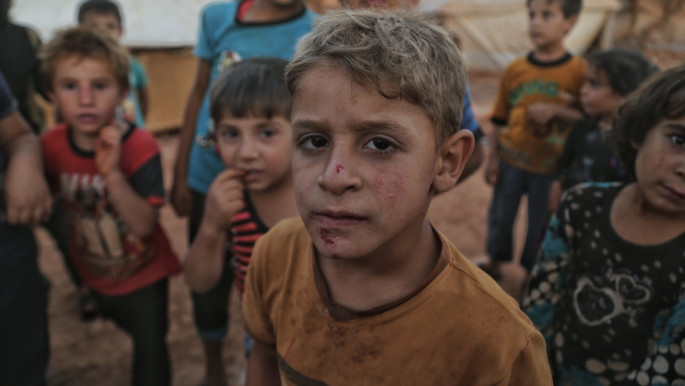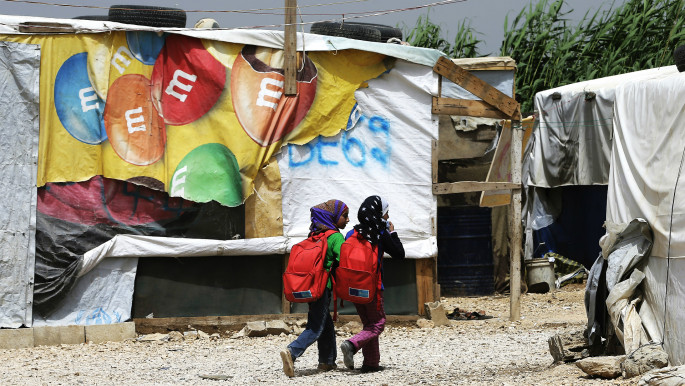'Risk their future, or risk their lives': Ten years on, Syrian children remain without education
The UN children's agency, UNICEF estimates that above 2.4 million children are out of school inside the country, of whom 40 percent are girls.
"The education system in Syria is overstretched, underfunded, fragmented and unable to provide safe, equitable and sustained services to millions of children," the Syria Crisis Regional Humanitarian Coordinator, Muhannad Hadi, and UNICEF Regional Director for the Middle East and North Africa, Ted Chaiban, said in a joint statement.
The number of boys and girls with no education has likely increased in 2020 due to the impact of the COVID-19 pandemic that compounded the disruption to education, according to the communiqué.
Furthermore, the United Nations reported that close to 700 attacks have hit education facilities and personnel since the verification of grave violations against children in the country began. Only last year, 52 aggressions were confirmed. A third of all schools "can no longer be used because they were destroyed, damaged, or are being used for military purposes", the UN statement added.
A decade-long conflict has adversely impacted on an already under-resourced education system under strain, and stolen the lives of a whole generation of children exposing them to violence and indiscriminate attacks, taking away their loved ones, their homes and possessions.
Schools and teaching staff have come under attack throughout Syria's war, putting children and teachers in extreme danger on a daily basis.
 |
|
| Read also: Assad's assault on Idlib's schools |
One of the most heavily affected countries by assaults on education, Syria has seen its schools becoming targets of attacks ranging from bombings on school buildings to looting and destruction pushing students and teachers to desert many places of learning.
A Syrian journalist, Qusay Noor, highlighted the war's harmful impact on education with many schools damaged or destroyed, educational supplies in ruins, teachers and pupils killed or maimed as a result.
"If you were lucky enough to have your child surviving bombs, you would not risk sending them back to school to be targeted again," he told The New Arab.
 |
If you were lucky enough to have your child surviving bombs, you would not risk sending them back to school to be targeted again |  |
The reporter pointed out that, apart from enduring the constant fighting, Syrian children struggle to survive daily since large numbers of them have fled their homes to end up living in tents with no regular food, little running water, no washing facilities nor cooling or heating available.
Charles Lawley, head of communications and advocacy at UK-based charity Syria Relief, recalled two heartbreaking incidents that occurred in 2020.
On January 1, one school run by the charity in Sarmin was hit by a cluster bomb attack that killed 12 and caused widespread destruction. Then Ghaith, a six-year-old child who attended another one of Syria Relief's school in the Idlib region was killed on New Year's Eve while collecting firewood after picking an unexploded cluster munition which he thought was a toy.
In late February 2020, a major air and ground aggression in Idlib hit 10 schools and kindergartens leaving 21 civilians dead, among them nine children and three teachers.
In the longer run, such attacks make children frightened to go to school while risking their lives, parents are afraid to send their kids to school and school personnel are also fearful, resulting in an entire generation of children at risk of being lost to a cycle of violence.
"Parents are given a really tough choice where they can either keep these children at home and risk their future, or send them to school and risk their lives", Syria Relief's head of advocacy noted speaking to The New Arab.
"There is very little doubt that children have been the first victims of the war in Syria, an entire generation who has known nothing but war, deprived of their childhood, their education, their well-being," Ambassador Carl Hallergard, Deputy Head of the EU Delegation to the UN in Geneva, stated in June of last year.
 |
|
| Read also: Coronavirus fears have triggered 'alarming' mental health crisis for displaced children in Syria, Yemen, Iraq |
"Their education is a life-saving activity that must continue, to avoid a lost generation."
The schools that are still operative often have overcrowded classrooms and are located in unsafe buildings with inadequate water and sanitation facilities, electricity, heating or ventilation, according to UNICEF.
Some children have been in and out of school, others have been cut off from school for ten years which makes it extremely difficult to catch up.
Noor warned the consequences for Syrian children staying out of school are far-reaching. "There will be a whole generation, or more than one, of people born or raised during the war who can't read or write, and can't get jobs," he uttered. "They will just be a burden for the society."
With huge numbers of people displaced by the ongoing fighting, youths have relocated, in some instances, multiple times, to escape the continued violence, losing their sense of home along with access to education opportunities.
 |
Some children have been in and out of school, others have been cut off from school for ten years which makes it extremely difficult to catch up |  |
More than three million Syrian children are internally displaced and 2.5 million are living as refugees in neighbouring Egypt, Iraq, Jordan, Lebanon and Turkey, based on UN estimates.
The number of children now in need humanitarian assistance and protection keeps increasing, with 4.8 million requiring education support this year.
Since Syria's war erupted in 2011, more than 387,000 people have been killed, and over half of its pre-war 23 million population have been forced to flee their homes.
Children in internally displaced people (IDP) camp sites in northwestern Syria particularly suffer from conditions depriving them of their right to education.
A report on education in IDP camps produced by independent media organisation, Syria Direct, last October highlighted some of the challenges displaced children in the Idlib province face during the coronavirus crisis.
The education sector experienced great instability in the northwestern region before the COVID-19 outbreak, but the implementation of distance learning policy that came with the virus spread left numerous children without any education as their families are either unable to provide them with the internet, or they cannot buy a laptop or mobile phone connecting them to their teachers.
 |
|
| Read also: A right to education: Saving Syrian refugee children from becoming a lost generation |
Since the beginning of the Syria crisis, humanitarian organisations have mobilised their efforts to ensure as many children as possible can access learning opportunities.
Education remains central to UNICEF's Syria crisis response, one of the largest humanitarian operations the UN children's agency has been conducting worldwide.
In cooperation with local partners, UNICEF continues to deliver educational services and materials, train teachers, rehabilitate schools that have been damaged, improve learning environments, provide psychosocial support, and offer recreational activities in some 500 social clubs within the country.
"It is pivotal that Syrian children have the opportunities they deserve, get educated and equipped with essential skills for their future," Juliette Touma, UNICEF Regional Chief of Communications for the Middle East and North Africa, told The New Arab. "Investing in children's education is the least that we can do."
 |
It is pivotal that Syrian children have the opportunities they deserve, get educated and equipped with essential skills for their future |  |
By the end of last year, the UN Children's fund launched an appeal for children of Syria requesting US $1 billion to respond to the most immediate needs of refugees and their education needs, inside Syria and in neighbouring countries.
Over half of the funds will be targeted at education with the aim of enabling 1.5 million children to access educational services, whether regular or non-formal.
The biggest NGO provider of education in the country, Syria Relief currently runs 306 schools in northern territory that host around 344 kids in every school, with classrooms counting 30-40 pupils each which is in line with International Network for Education in Emergencies (INEE) minimum standards.
The UK charity delivers across all its schools quality education, psychological support and life-sustaining skills including how to recognise and avoid explosive devices.
The NGO operates mobile learning centres, which benefit 4,500 children, traveling to some of the hardest to reach areas in Syria. It also rebuilds schools, with 353 facilities rebuilt in 2019 alone.
"I hope this 10-year war anniversary serves to raise attention on how humanitarian needs in Syria are growing exponentially, and send the message that we ought to make justice to Syrian children," Lawley appealed.
Alessandra Bajec is a freelance journalist currently based in Tunis.
Follow her on Twitter: @AlessandraBajec





 Follow the Middle East's top stories in English at The New Arab on Google News
Follow the Middle East's top stories in English at The New Arab on Google News


